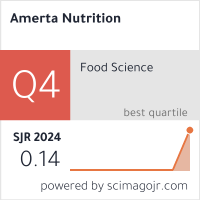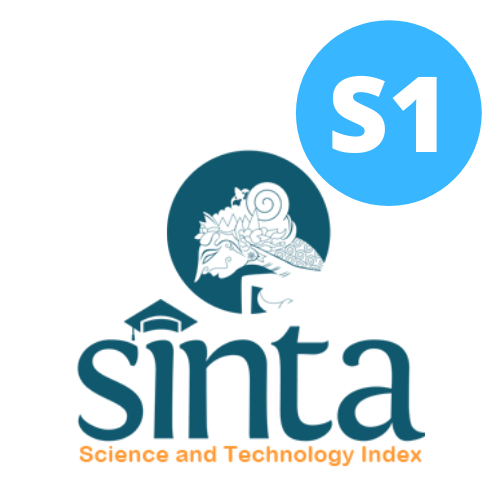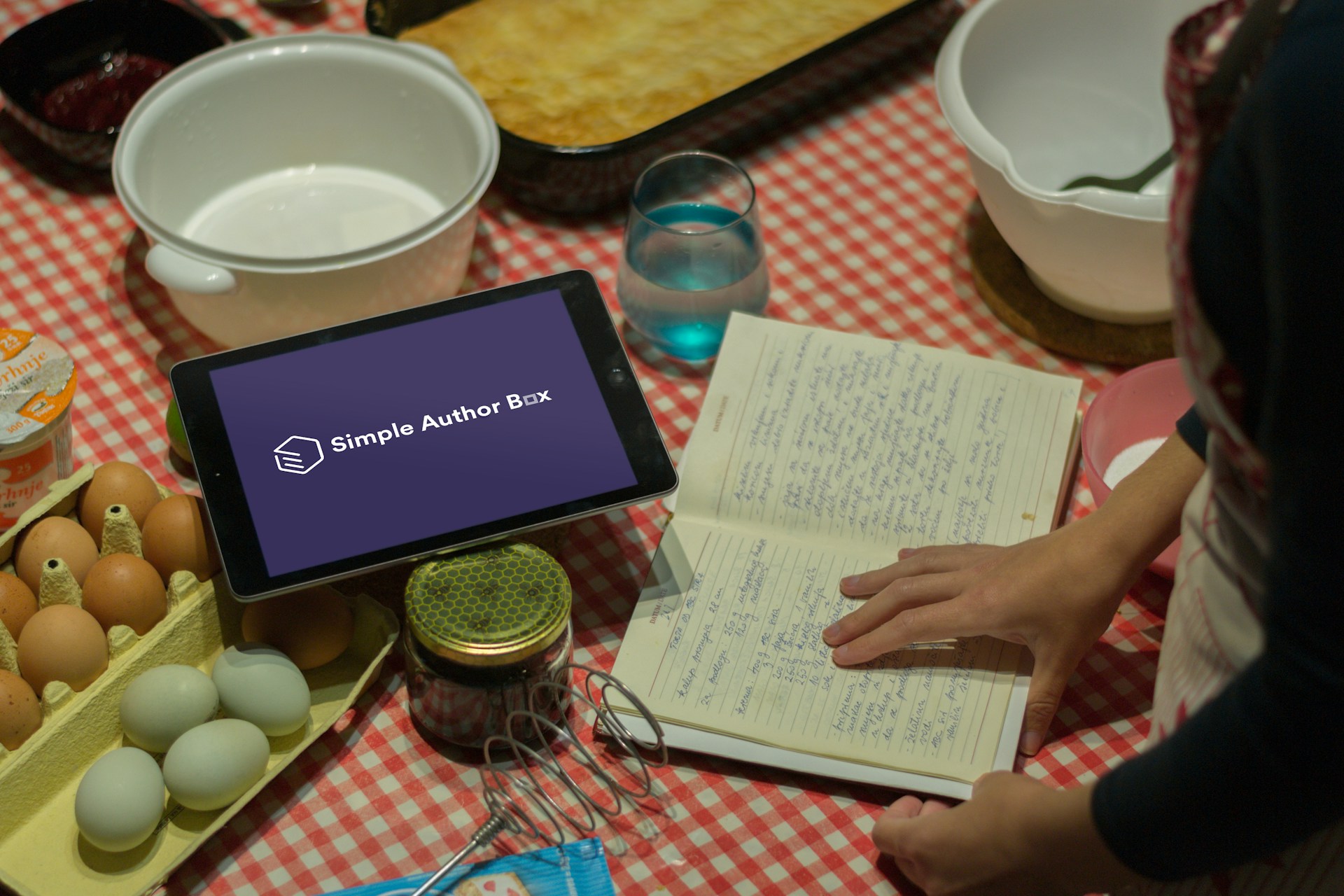The Effect of Vitamin D3-Fortified Goat Milk Kefir on hs-CRP Levels of Type 2 Diabetic Rattus norvegicus Rats
Background: Insulin resistance and chronic hyperglycemia in diabetes mellitus are associated with the synthesis of the inflammatory biomarker hs-CRP. Goat milk kefir and vitamin D have anti-diabetic and anti-inflammatory properties.
Objectives: This study aims to determine the effect of goat milk kefir fortified with vitamin D3 on hs-CRP levels of diabetic rats.
Methods: A true experimental study with a pre-post control group design was conducted in 35 days, involving 21 Rattus norvegicus male rats divided into four groups randomly: negative control (K-), positive control (K+), unfortified goat milk kefir treatment (P1), and vitamin D3-fortified goat milk kefir treatment (P2). Diabetes induced by STZ 65 mg/kg BW and NA 230 mg/kg BW intraperitoneally. Goat's milk kefir was given orally at 2 mL/200 g BW/day and a vitamin D3 fortification dose of 600 IU/100 mL kefir. Pre and post of fasting blood glucose levels were measured using the GOD-PAP method and serum hs-CRP was assessed by Enzyme-Linked Immunosorbent Assay (ELISA). Data were analyzed bivariate and multivariately using GraphPad Prism 8 software.
Results: There was a statistically insignificant decrease in hs-CRP levels in the P2 group (p 0,2111) and in the P1 group (p 0,6250). However, there was a statistically significant drop in blood glucose levels in the P2 group (∆FBG -65,50 ± 35.44 mg/dL, p 0.0344) and in the P1 group (∆FBG -81,63 ± 50.07 mg/dL, p 0.0470).
Conclusions: Vitamin D3-fortified goat milk kefir can decrease hs-CRP levels of Rattus norvegicus diabetes rats, but statistically insignificant.
International Diabetes Federation. IDF Diabetes Atlas Ninth edition 2019: 463 million people living with diabetes. (2019).
World Health Organization. Global Report on Diabetes. (2016).
Prasad, M., Chen, E. W., Toh, S. A. & Gascoigne, N. R. J. Autoimmune responses and inflammation in type 2 diabetes. J. Leukoc. Biol. 107, 739–748 (2020).
Carrero, J. J., Andersson Franko, M., Obergfell, A., Gabrielsen, A. & Jernberg, T. hsCRP Level and the Risk of Death or Recurrent Cardiovascular Events in Patients With Myocardial Infarction: a Healthcare-Based Study. J. Am. Heart Assoc. 8, e012638 (2019).
Hadisaputro, S., Djokomoeljanto, R. R. J., Judiono & Soesatyo, M. H. N. E. The Effects of Oral Plain Kefir Supplementation on Proinflammatory Cytokine Properties of the Hyperglycemia Wistar Rats Induced by Streptozotocin. Acta Medica Indones. - Indones. J. Intern. Med. 44, 100–104 (2012).
Gupta, R. & Soni, S. An Overview on Inflammatory Biomarkers for Diabetes Mellitus. Madridge J. Diabetes 3, 63–65 (2019).
Kalma. Studi Kadar C-Reactive Protein (CRP) Pada Penderita Diabetes Melitus Tipe 2. J. Media Anal. Kesehat. 1, 62–68 (2018).
Elimam, H., Abdulla, A. M. & Taha, I. M. Inflammatory markers and control of type 2 diabetes mellitus. Diabetes Metab. Syndr. Clin. Res. Rev. 13, 800–804 (2019).
Gedebjerg, A. et al. CRP, C-Peptide, and Risk of First-Time Cardiovascular Events and Mortality in Early Type 2 Diabetes: A Danish Cohort Study. Diabetes Care 46, 1037–1045 (2023).
Bayani, M. A., Akbari, R., Banasaz, B. & Saeedi, F. Status of Vitamin-D in diabetic patients. Casp. J. Intern. Med. 5, 40–2 (2014).
Xiao, Y., Wei, L., Xiong, X., Yang, M. & Sun, L. Association Between Vitamin D Status and Diabetic Complications in Patients with Type 2 Diabetes Mellitus : A Cross-Sectional Study in Hunan China. Front. Endocrinol. (Lausanne). 11, 564738 (2020).
Mitri, J. & Pittas, A. G. Vitamin D and diabetes. Endocrinol. Metab. Clin. North Am. 43, 205–232 (2014).
Chai, X., Jin, Y., Wei, Y. & Yang, R. The effect of vitamin D supplementation on glycemic status and C-reactive protein levels in type 2 diabetic patients with ischemic heart disease: A protocol for systematic review and meta-analysis. Medicine (Baltimore). 101, e32254 (2022).
Yu, Y., Tian, L., Xiao, Y., Huang, G. & Zhang, M. Effect of Vitamin D Supplementation on Some Inflammatory Biomarkers in Type 2 Diabetes Mellitus Subjects: A Systematic Review and Meta-Analysis of Randomized Controlled Trials. Ann. Nutr. Metab. 73, 62–73 (2018).
Acharya, A. & Halemani, S. S. Role of Vitamin D in Diabetes Mellitus. Int. J. Pharm. Sci. Res. 7, 1881–1888 (2016).
Gupta, A., Kumar, D., Rajvanshi, S., Kumar, A. & Arya, T. To study the association of high sensitivity C-reactive protein with newly diagnosed DM type 2. Journal, Indian Acad. Clin. Med. 16, 12–15 (2015).
Espersen, R. et al. Influence of food matrix delivery system on the bioavailability of vitamin D3: A randomized crossover trial in postmenopausal women. Nutrition 107, 111911 (2023).
Safitri, G. R. & Saktini, F. Pengaruh Pemberian Susu Kambing Terhadap Gambaran Mikroskopis Hepar dan Kadar SGPT Tikus Wistar yang Terpapar Asap Kendaraan Bermotor. Media Med. Muda 4, 834–848 (2015).
Leeuwen, S. S. van et al. Goat Milk Oligosaccharides: Their Diversity, Quantity, and Functional Properties in Comparison to Human Milk Oligosaccharides. J. Agric. Food Chem. 68, 13469–13485 (2020).
Park, Y. W., Juárez, M., Ramos, M. & Haenlein, G. F. W. Physico-chemical characteristics of goat and sheep milk. Small Rumin. Res. 68, 88–113 (2007).
Kibre, D., Tkue, T. & Fesseha, H. The Composition and Role of Goat Milk in Lactose Intolerance - A Review. World Appl. Sci. J. 38, 302–308 (2020).
Stergiadis, S., Ní¸rskov, N. P., Purup, S., Givens, I. & Lee, M. R. F. Comparative Nutrient Profiling of Retail Goat and Cow Milk. Nutrients 11, 2282 (2019).
Fauziyyah, F., Panunggal, B., Afifah, D. N., Rustanti, N. & Anjani, G. Microbiological Characteristic and Nutrition Quality of Goat Milk Kefir Based on Vitamin D3 Fortification Time. in IOP Conference Series: Earth and Environmental Science vol. 116 012040 (2018).
Azizi, N. F. et al. Kefir and Its Biological Activities. Foods 10, 1210 (2021).
Setyawardani, T., Sumarmono, J., Rahardjo, A. H. D., Sulistyowati, M. & Widayaka, K. Kualitas Kimia, Fisik dan Sensori Kefir Susu Kambing yang Disimpan pada Suhu dan Lama Penyimpanan Berbeda. Bul. Peternak. 41, 298–306 (2017).
Marsh, A. J., O'Sullivan, O., Hill, C., Ross, R. P. & Cotter, P. D. Sequencing-Based Analysis of the Bacterial and Fungal Composition of Kefir Grains and Milks from Multiple Sources. PLoS One 8, e69371 (2013).
Bourrie, B. C. T., Willing, B. P. & Cotter, P. D. The Microbiota and Health Promoting Characteristics of the Fermented Beverage Kefir. Front. Microbiol. 7, 647 (2016).
Ostadrahimi, A. et al. Effect of Probiotic Fermented Milk (Kefir) on Glycemic Control and Lipid Profile In Type 2 Diabetic Patients: A Randomized Doube-Blind Placebo-Controlled Clinical Trial. Iran. J. Public Health 44, 228–237 (2015).
Nurliyani, Harmayani, E. & Sunarti. Antidiabetic Potential of Kefir Combination from Goat Milk and Soy Milk in Rats Induced with Streptozotocin-Nicotinamide. Korean J. Food Sci. Anim. Resour. 35, 847–858 (2015).
Hasan Al-Sheraji, S., Ismail, A., Azlan, A. & Manap, M. Nutrigenomic Effects of Fermented Milk Containing Bifidobacterium longum Bb536 on Hepatic Cholesterologenic Genes in Hypercholesterolemic Rats. Adv. Dairy Res. 07, 220 (2019).
Rasipin, R., Dharmana, E., Hadisaputro, S. & . S. THE EFFECTS OF KEFIR ON THE INFLAMATORY STATUS AND THYROID FUNCTION (EXPERIMENTAL STUDY ON WISTAR RATS AFTER EXPOSED TO CHLORPYRIFOS). Asian J. Pharm. Clin. Res. 9, 165 (2016).
Nurliyani, Harmayani, E. & Sunarti. Nitric Oxide and Inflammatory Cytokine Productions in Diabetic Rats Supplemented with Goat Milk and Soy Milk Kefir. J. Food Nutr. Res. 3, 384–391 (2015).
Abyyudha, D., Widyastuti, N. & Anjani, G. KELARUTAN VITAMIN D3 (Cholecalciferol) DALAM SISTEM KEFIR SUSU KAMBING. J. Nutr. Coll. 8, 138–145 (2019).
Menteri Kesehatan RI. Peraturan Menteri Kesehatan Nomor 28 Tahun 2019 tentang Angka Kecukupan Gizi yang Dianjurkan untuk Masyarakat Indonesia. Database Peraturan JDIH BPK 1–33 https://peraturan.bpk.go.id/Details/138621/permenkes-no-28-tahun-2019 (2019).
LukaÄínová, A., Hubková, B., Rácz, O. & NiÅ¡tiar, F. Animal Models for Study of Diabetes Mellitus. in Diabetes Mellitus - Insights and Perspectives 229–254 (InTech, 2013). doi:10.5772/48325.
Masiello, P. et al. Experimental NIDDM: Development of a New Model in Adult Rats Administered Streptozotocin and Nicotinamide. Diabetes 47, 224–229 (1998).
Pangaribuan, A. & Batubara, F. R. Relationship of Adrenaline Administration to Increased Blood Sugar Levels in Male Rattus norvegicus Rats. J. Complement. Altern. Med. Res. 21, 1–7 (2023).
Sharif, M., Baig, A., Sarwari, K. N. & T, M. S. STUDY OF SERUM hs-CRP IN TYPE 2 DIABETIC PATIENTS. Int. J. Basic Appl. Med. Sci. 3, 235–240 (2013).
Yerizel, E., Hendra, P., Edward, Z. & Bachtiar, H. PENGARUH HIPERGLIKEMIA TERHADAP HIGH SENSITIVE C REACTIVE PROTEIN (Hs-CRP) PADA PENDERITA DIABETES MELITUS TIPE 2. in Prosiding Seminar Ilmiah Perhimpunan Biokimia & Biologi Molekuler Indonesia (eds. Yuwono, T. et al.) 51–55 (Bagian Biokimia Fakultas Kedokteran Universitas Gadjah Mada, 2015).
Judiono, Purwaningsih, E., Djokomoeljanto, R. & Hadisaputro, S. Pengaruh Pemberian Kefir Bening Terhadap Kadar Glukosa Darah Pada Tikus Wistar Hiperglikemia Yang Dinduksi Streptozotocin (STZ). Penelit. Gizi dan Makanan 32, 131–138 (2009).
Amanullah, S., Jarari, A., Govindan, M., Basha, M. I. & Khatheeja, S. Association of hs-CRP with Diabetic and Non-diabetic individuals. Jordan J. Biol. Sci. 3, 7–12 (2010).
Hong, E.-G. et al. Interleukin-10 Prevents Diet-Induced Insulin Resistance by Attenuating Macrophage and Cytokine Response in Skeletal Muscle. Diabetes 58, 2525–2535 (2009).
Goyal, S. N. et al. Challenges and issues with streptozotocin-induced diabetes – A clinically relevant animal model to understand the diabetes pathogenesis and evaluate therapeutics. Chem. Biol. Interact. 244, 49–63 (2016).
Butkowski, E. G. & Jelinek, H. F. Hyperglycaemia, oxidative stress and inflammatory markers. Redox Rep. 22, 257–264 (2017).
Lamb, R. E. & Goldstein, B. J. Modulating an oxidative-inflammatory cascade: potential new treatment strategy for improving glucose metabolism, insulin resistance, and vascular function. Int. J. Clin. Pract. 62, 1087–1095 (2008).
Judiono, Djokomoeljanto & S, H. Biomolecular aspects of plain kefir antidiabetic potentials. Int. J. Food, Nutr. Public Heal. 5, 7–23 (2012).
Talaei, A., Mohamadi, M. & Adgi, Z. The effect of vitamin D on insulin resistance in patients with type 2 diabetes. Diabetol. Metab. Syndr. 5, 1–5 (2013).
Song, Y. et al. Blood 25-Hydroxy Vitamin D Levels and Incident Type 2 Diabetes. Diabetes Care 36, 1422–1428 (2013).
Li, X., Liu, Y., Zheng, Y., Wang, P. & Zhang, Y. The Effect of Vitamin D Supplementation on Glycemic Control in Type 2 Diabetes Patients: A Systematic Review and Meta-Analysis. Nutrients 10, 375 (2018).
Girgis, C. M., Clifton-Bligh, R. J., Hamrick, M. W., Holick, M. F. & Gunton, J. E. The Roles of Vitamin D in Skeletal Muscle: Form, Function, and Metabolism. Endocr. Rev. 34, 33–83 (2013).
MAESTRO, B., CAMPIí“N, J., DÁVILA, N. & CALLE, C. Stimulation by 1,25-Dihydroxyvitamin D3 of Insulin Receptor Expression and Insulin Responsiveness for Glucose Transport in U-937 Human Promonocytic Cells. Endocr. J. 47, 383–391 (2000).
Sunarti, Nurliyani, Tyas, A. S. A., Kristian, S. D. & Prasetyastuti. THE INFLUENCE OF GOAT MILK AND SOYBEAN MILK KEFIR ON IL-6 AND CRP LEVELS IN DIABETIC RATS. Rom. J. Diabetes Nutr. Metab. Dis. 22, 261–267 (2015).
Daddaoua, A. et al. Goat Milk Oligosaccharides Are Anti-Inflammatory in Rats with Hapten-Induced Colitis. J. Nutr. 136, 672–676 (2006).
Davras, F., Zeynep Banu Guzel-Seydim & Tas, T. K. Immunological effects of Kefir produced from Kefir grains versus starter cultures when fed to mice. Funct. Foods Heal. Dis. 8, 367–378 (2018).
Curciarello, R. et al. Probiotic Lactobacilli Isolated from Kefir Promote Down-Regulation of Inflammatory Lamina Propria T Cells from Patients with Active IBD. Front. Pharmacol. 12, 658026 (2021).
Bohlouli, J. et al. Effect of probiotics on oxidative stress and inflammatory status in diabetic nephropathy: A systematic review and meta-analysis of clinical trials. Heliyon 7, e05925 (2021).
Thomas, C. M. & Versalovic, J. Probiotics-host communication. Gut Microbes 1, 148–163 (2010).
Takeuchi, O. et al. Cutting Edge: Role of Toll-Like Receptor 1 in Mediating Immune Response to Microbial Lipoproteins. J. Immunol. 169, 10–14 (2002).
Szkudelski, T., Zywert, A. & Szkudelska, K. Metabolic Disturbances and Defects in Insulin Secretion in Rats With Streptozotocin-Nicotinamide-Induced Diabetes. Physiol. Res. 62, 663–670 (2013).
Pepys, M. B. & Hirschfield, G. M. C-reactive protein: a critical update. J. Clin. Invest. 111, 1805–1812 (2003).
Sartang, M. M., Mazloomi, S. M., Tanideh, N. & Zadeh, A. R. The Effects of Probiotic Soymilk Fortified with Omega-3 on Blood Glucose, Lipid Profile, Haematological and Oxidative Stress, and Inflammatory Parameters in Streptozotocin Nicotinamide-Induced Diabetic Rats. J. Diabetes Res. 2015, 1–9 (2015).
Chen, N. et al. Effect of Vitamin D Supplementation on the Level of Circulating High-Sensitivity C-Reactive Protein: A Meta-Analysis of Randomized Controlled Trials. Nutrients 6, 2206–2216 (2014).
Almatsier, S. VITAMIN DAN VITAMIN LARUT LEMAK. in Prinsip dasar ilmu gizi 151–184 (Gramedia Pustaka Utama, 2009).
Rabinovitch, A., Suarez-Pinzon, W. L., Sooy, K., Strynadka, K. & Christakos, S. Expression of Calbindin-D 28k in a Pancreatic Isletβ -Cell Line Protects against Cytokine-Induced Apoptosis and Necrosis. Endocrinology 142, 3649–3655 (2001).
Yang, L.-P. et al. Tissue-Specific Regulatory Effects of Vitamin D and Its Receptor on Calbindin- D28K and Calbindin-D9K. Biochem. Mol. Biol. J. 4, 1–9 (2018).
Sooy, K. et al. Calbindin-D28k Controls [Ca2+]i and Insulin Release. J. Biol. Chem. 274, 34343–34349 (1999).
Chen, Y. et al. Vitamin D Receptor Inhibits Nuclear Factor κB Activation by Interacting with IκB Kinase β Protein. J. Biol. Chem. 288, 19450–19458 (2013).
Arafat, E. S., Taha, I. M., Kattan, S. W., Babteen, N. A. & Fawzy, I. Associations between Vitamin D and Type 2 Diabetes Mellitus: The Role of Vitamin D Receptor and Binding Protein. J. Diabetes Mellit. 10, 222–235 (2020).
Dinić, S. et al. Oxidative stress-mediated beta cell death and dysfunction as a target for diabetes management. Front. Endocrinol. (Lausanne). 13, 1006376 (2022).
Kuwabara, W. M. T., Yokota, C. N. F., Curi, R. & Alba-Loureiro, T. C. Obesity and Type 2 Diabetes mellitus induce lipopolysaccharide tolerance in rat neutrophils. Sci. Rep. 8, 17534 (2018).
Nugroho, F. A., Ginting, R. M. S. & Nurdiana. Kadar NF- Kβ Pankreas Tikus Model Type 2 Diabetes Mellitus dengan Pemberian Tepung Susu Sapi. Indones. J. Hum. Nutr. 2, 91–100 (2015).
Gatineau, M. et al. Adult obesity and type 2 diabetes. (Public Health England, 2014).
Hernaningsih, Y. & Novianti, D. A. The Effect of Hemolysis on Hematology Laboratory Test. in Advances in Health and Disease (ed. Duncan, L. T.) vol. 25 117–148 (Nova Science, 2020).
Nikolac, N. Lipemia: Causes, interference mechanisms, detection and management. Biochem. Medica 24, 57–67 (2014).
Faber, J. & Fonseca, L. M. How sample size influences research outcomes. Dental Press J. Orthod. 19, 27–29 (2014).
Copyright (c) 2025 Amerta Nutrition

This work is licensed under a Creative Commons Attribution-ShareAlike 4.0 International License.
AMERTA NUTR by Unair is licensed under a Creative Commons Attribution-ShareAlike 4.0 International License.
1. The journal allows the author to hold the copyright of the article without restrictions.
2. The journal allows the author(s) to retain publishing rights without restrictions
3. The legal formal aspect of journal publication accessibility refers to Creative Commons Attribution Share-Alike (CC BY-SA).
4. The Creative Commons Attribution Share-Alike (CC BY-SA) license allows re-distribution and re-use of a licensed work on the conditions that the creator is appropriately credited and that any derivative work is made available under "the same, similar or a compatible license”. Other than the conditions mentioned above, the editorial board is not responsible for copyright violation.








































